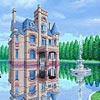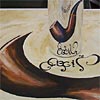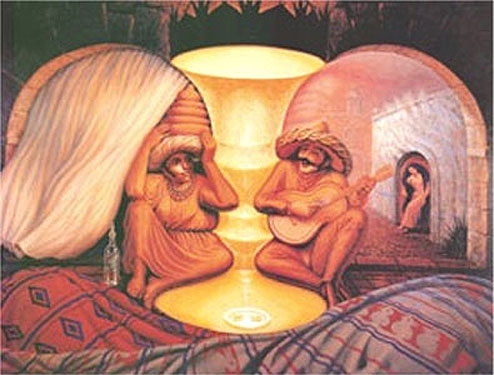|


|

Octavio Ocampo paints the most amazing metamorphic art in the world. It is the most original art coming out of Mexico today. If you love Salvador Dali and Mexican art, you will love Octavio Ocampo. These wonderful images are available as posters and prints in a variety of sizes. When it comes to religious art, The Calvary and Miracle of the Roses are the most unique representations of Christ and the Virgin Mary that you will ever see. Experience the magic! Octavio Ocampo was born in Celaya, Guanajuato, Mexico on February 28, 1943. Growing up in a family of designers, he first studied art as a boy. Professor Salvador Zuniga directed the local art school in his hometown. At the art school, Ocampo constructed "paper mache" figures for floats, altars and ornaments that were used during carnival parades and other festivals. By doing this, he learned about art composition, materials and techniques. In high school, Ocampo painted murals for the Preparatory School and the City Hall of Celaya. Ruth Rivera, daughter of artist and muralist Diego Rivera and Maria Luisa "La China" Mendoza saw his work and encouraged him to attend the School of Painting and Sculpture of the National Fine Art Institute. Octavio Ocampos' talents were not limited to painting and sculpture, but also extended to acting and dancing. While at the Art Institute of San Francisco, he studied all these disciplines and pursued both a film and theater career. In 1976, he began to devote himself solely to painting and sculpture. He now work primarily in the metamorphic style - using a technique of superimposing and juxtaposing realistic and figurative details within the images that he creates. One has to look long & hard at Octavio's paintings. The longer one looks at his work, the more that is revealed. Faces come into focus at a distance and metamorphose into something else entirely in close up. Flowers become faces, mountains speak to each other, and mourners over a coffin become the face of Christ. His works are full of symbolism, endlessly fascinating, each revealing a new facet, different to each viewer.
Calvary is a painting of hope. Christ’s face is heavy with sorrow as he takes on the sins of the world and makes his incredible sacrifice on the cross. Through the face of Jesus suffering, we can see the crucifixion which is the sacrifice Christ made for all humanity. The middle left side of the painting depicts the sacrifices made by Christian martyrs. The scriptures tell us that it was Christ’s sacrifice that opened the gates of hell so that the souls there (lower left) could ascend to heaven with the help of God’s angels (middle right). The ravens on the upper left represent the cares, sorrows, and sins of this world. But through the sacrifice and with the help of the Father, Son and the Holy Ghost (three eyes in upper center); those ravens are muted and made bearable (below the third eye). The right most eye represents the Holy Ghost, it is encircled with doves symbolizing its peace and love. Thus through the sacrifice and the Trinity, humanity is freed from the bondage of care, strife and sin. The artist appears in the work (lower right), representing St. John as well as all of humanity. This shows the benefits from the forgiveness bought by Christ’s sacrifice and glories in the hope that this brings. The cloth robe worn by the artist on the lower right is a representation of the cloth pressed to Christ’s face by Veronica on which his countenance was indelibly imprinted. The cloth pictured shows Veronica’s face crying in anguish for the pain that Christ had to endure on the cross. The "Calvary" is a vision of the time and place where all of humanity and hope for salvation and a life in God’s grace was born. We should look upon it as an eternal reminder of God’s love for the world and everyone in it. "For God so loved the world that he gave his one and only Son that whoever believes in him shall not perish, but have eternal life." (John 3:16) Octavio Ocampo paints in a style that he terms as "metamorphic". This name is appropriate for two reasons. The first is that his pictures appear classical in nature, but upon closer examination we realize that what was first seen appears to be something else entirely. The second metamorphosis transpires within the viewer of the work as he is given a glimpse of his preconceptions and how they effect what he sees. It is uncanny how what we most need to see, appears most prominently to us and can in fact be a comfort and guide as we interact with the metamorphic work and through it with our own subconscious.
The latest in the "Lilies" series, "Ecstasy of the Lilies", continues our exploration of the magic and mystery that accompanies the female's transformation from girlhood to womanhood through the power, passion, and energy that is the threshold of awakening. Depicted is a girl dressed up for her "Coming out Party", which is symbolic of her official transition from girlhood to womanhood. The viewer should note that the lilies are indoors, alluding to her eventual role as the heart and soul of the "home". The artist keeps her innocence intact through this transition by keeping her eyes closed to the world. The ecstasy of limitless possibility and freedom is personified by the electric effect of this artwork on the viewer. Though tempered by the sweet innocence of the face and expression this image holds the power to captivate.
Man holds the fate of the world in his hand. He can make the choice to destroy it or make it a better place. Man must have the vision (see the face looking at the globe in its hand, made of two angels) and the love of god (the two angels that make up the face) to safeguard the delicate balance of life on this small planet. In the lower right corner, an older soul helps one just beginning its journey to travel from its life in the old world (see face in the upper globe) to a new life in a younger world (see lower face). The center of the painting depicts an elder soul embracing and guiding a dreamer as he travels far from home.
Forever Always by Octavio Ocampo is a depiction of a life well lived or of one that will be well lived. Those who see the older couple can note that they share the Cup of Life (center of the picture) and the crown of fidelity (above the cup). Both of these are symbols of the life they have shared together and the love that fills the cup with a golden light. The older couple sees each other as they were when they were much younger and they courted with serenades while drinking tequila with limes (lower center). The viewer is able to look into the older man’s mind to note that he always sees his chosen as beautiful and desirable. Those who view the younger couple see that they are looking forward to sharing a cup full of love and happiness. This sharing becomes their crowning achievement symbolized by the ring (crown) they wear. The young man remembers how his love came out of her house in response to his serenades.
James Dean was born February 8, 1931, in Marion, Indiana, to Winton and Mildred Dean. His father, a dental technician, moved the family to Los Angeles when Jimmy was five. He returned to the Midwest after his mother passed away and was raised by his aunt and uncle on their Indiana farm. After graduating from high school, he returned to California where he appeared in occasional television commercials, and played several roles in films and on stage. His last appearance resulted in a screen test at Warner Brothers for the part of Cal Trask in the screen adaptation John Steinbeck's novel East of Eden. After winning the role of Jim Stark in 1955's Rebel Without A Cause, he moved to Hollywood. James Dean had one of the most spectacularly brief careers of any screen star. In just more than a year, and in only three films, Dean became a widely admired screen personality, a personification of the restless American youth of the mid-50's, and an embodiment of the title of one of his films Rebel Without A Cause. En route to compete in a race in Salinas, James Dean was killed in a highway accident on September 30, 1955. James Dean was nominated for two Academy Awards, for his performances in East of Eden and Giant. Although he only made three films, they were made in just over one year's time. "..There is no simple explanation for why he has come to mean so much to so many people today. Perhaps it is because, in his acting, he had the intuitive talent for expressing the hopes and fears that are a part of all young people... In some movie magic way, he managed to dramatize brilliantly the questions every young person in every generation must resolve."
John Lennon was born on October 9, 1940 to Alfred and Julia Lennon. John's father, a merchant seaman, deserted his family when John was four years old. He was sent to live with Julia's sister Mimi and her husband George. The early trauma of being left by his parents left severe emotional scars on John, which years later, he would attempt to heal with the whole world watching. From the moment he heard American rock and roll, John's life was forever altered. On July 6, 1957, he met 14 year-old Paul McCartney. Paul would join the Quarrymen shortly thereafter and a legendary partnership was formed. The next eight years of Beatles fame, fortune, and trail blazing would see John become half of one of the most successful and celebrated songwriting partnerships in history. However, those years were not always happy ones for John. He found that he often had to be less than who he really was in order to retain the popularity of the Beatles, hiding what he really felt rather than being allowed to speak his mind. He would turn to drugs and later, meditation as all the Beatles did, in search of answers and in attempt to transcend his pain, but these proved dead ends for him. Before and after the Beatles break-up in 1970, John and Yoko fought for a host of political and spiritual causes, all centered on the themes of peace, love and justice. Although they were heavily berated for their often-outlandish exploits, both musical and political, John would come to be as loved for his ideology as for his music. As a solo artist, John was able to bare his soul, as he never could as a Beatle, and getting in touch with his childhood pain and anger. After the release of, Imagine, featuring his signature song of the same name, John and Yoko left England to live in New York City. On December 8, 1980, the unthinkable happened. John Lennon was assassinated by a deranged fan named Mark David Chapman. The worldwide outpouring of grief and outrage over this tragedy may have been excessive in intensity and amount, had it been for virtually anybody else. The world lost a beloved artist, a modern-day philosopher, an adored role model, and a most remarkable human being. In Loving Memory (October 9, 1940-December 8, 1980)
In the fall of 1929, she was "discovered" by Josef von Sternberg and contracted to star in The Blue Angel. Although this film was made in Germany, Dietrich moved to the U.S. to fulfill a 6-movie contract with Paramount. Von Sternberg directed all but one of these. Dietrich credited von Sternberg with creating her. Von Sternberg claimed that he portrayed Dietrich just as she was. Clearly von Sternberg taught her most of what she learned about the process of making a movie and specifically her image. Her major claim to fame in this period is her work with the USO. Although much has been made of her hobnobbing with the U.S. brass, there is no doubt that she made a major contribution to the morale of the troops. In the French & German campaign she often rode with Patton at the front. Her vehement denouncement of the Nazi regime and her participation in Radio broadcasts aimed at Germany got the desired result - she got under the skin of the Nazis. For her work, the U.S., French and (eventually) Israeli governments awarded her medals. In 1950, Dietrich made one of her great movies. Stage Fright by Alfred Hitchcock is not a superficial movie; perhaps that is why it was one of his less well-received outings initially. However, it's reputation has grown over the years and rightly so. In 1957 she made another great movie, Witness for the Prosecution, which was Dietrich's most dynamic role. Marlene Dietrich died of kidney and liver failure in her Paris apartment on May 6, 1992.
Visions of Quixote illustrates Octavio Ocampo’s powerful ability to tell the story of Don Quixote by using a single picture. From afar, the viewer sees an old man with a faraway and dreamlike expression on his face. Wild yellow hair and strange beard serve to complete man’s strange demeanor. Coming closer, the viewer is transported to the Spanish countryside, where he notices that the windmills in the center of the picture look like they are about to come to life. Two proud heroes occupy the center of the picture and are backed by windmills. Don Quixote on his faithful steed Rocinante and Sancho Panzo on Dappie. They are surrounded by the world that lives in Don Quixote’s mind. In the middle of the right picture, Don Quixote is immortalized protesting that a deceased man still lives and getting ready to hijack his body to save him from an untimely funeral. If you focus on the area around this scene, you will see the face of a dog, or a symbol of Quixote’s madness. The middle left of the picture shows Xarifa working in the fields. Again this scene appears to be the face of a dog, to show the madness of imagining her to be Dulcinea (pictured in the upper left corner). Above Xarifa in the fields, the village of La Mancha is pictured surrounded by mythical dragons and sea monsters. Above the village, sits the Duke’s castle (upper left) with the Duke’s face pictured in the castle’s wall. Careful observation will reveal a skull outlining the left side of the castle, a hint of the Duke’s sinister plans for our heroes. The upper right side of the painting shows Miguel de Cervantes’ ghostly face watching over his work. While the hills, rocks, and dales alter with the power of the Man of La Mancha’s madness.
Miracle of the Roses by Octavio Ocampo is a depiction of the culmination of the story of Our Lady of Guadeloupe, the Virgin Mary. In the days of the conquest of Central America, and near the place where Mexico City would one-day stand, there was a small village. Now it came to pass that the Bishop of the village wanted to build a cathedral in honor of the Virgin Mary, but neither the Bishop nor the other leaders knew where the site of the cathedral should be. Most of the villagers were the native inhabitants of Central America, they lived in poverty and were treated little better than slaves. But one among them, who was called Juan Diego, was a very devout man and served God to the best of his abilities. One day while working in the fields, he met a beautiful lady who seemed to have a warmth and radiance about her. When he came closer, she spoke to him and said, "Go to the Bishop and tell him that I wish the church he would dedicate to me to be built on this spot." Bowing respectfully, Juan Diego immediately set off to see the Bishop, but being busy, the Bishop was only able to see him after several days. After Juan was finally ushered into the Bishop’s presence, he proceeded to describe what he had seen and tell the Bishop the message that was given to him. The Bishop thought that Juan was crazy and had him thrown out. Juan Diego returned to the spot where he had met the lady and there she appeared to him a second time. "Go again to the Bishop and tell him that I wish the church be built on this spot," she spoke. Juan again returned and asked for an audience with the Bishop. This time after a much longer wait he was again brought before the Bishop. After Juan had recounted his second meeting with the lady, the Bishop said, ‘If it is the Virgin, who speaks with you, then bring me some proof of this!" For the third time Juan returned to the spot where he had met the Virgin, and again she appeared to him. He proceeded to tell her that the Bishop wanted some proof from him to show that he really spoke to her. Now at this time there were no roses in the New World, and it was the middle of December. But when the Virgin placed her hand on the earth, roses suddenly grew and bloomed in moments. Juan took the roses and piled them in the front of his tabard, and rushed off to the Bishop. Pictured in Octavio Ocampo’s painting Miracle of the Roses is the culminating scene of this story where Juan Diego comes into the Bishop’s presence bearing the proof from the Virgin. He lets go of his tabard showering the astonished Bishop with roses, only to find that the symbol of the Madonna is now indelibly marked on the front of his tabard. His tabard can still be seen in the cathedral that was built to honor the Virgin.
Mona Lisa’s Chair is Octavio Ocampo’s compliment to the magnificent work of Leonardo DaVinci, Mona Lisa. The picture consists of a chair occupied by three rabbits, one black (on the lower left) and two whites (in the lower center). A cat sits on the chair’s upper cushions (middle center) and watches the viewer of the piece. The chair has a mirrored back, that at first glance appears to be the face of Mona Lisa, but upon closer inspection actually consists of two women, a man, an angel, as well as a skyline. It is interesting to imagine that because Mona Lisa’s face came from the imagination of Leonardo DaVinci, Mona Lisa’s face may hold the clues to DaVinci’s thoughts at the time he painted her. The background in The Mona Lisa’s chair is a study of the subconscious mind as face turns into forms and nothing is really what it seems at first.
As Jesus and his disciples drew near to Jerusalem, he sent two of the disciples with these instructions: "Go into the village straight ahead of you. Upon entering you will find an ass tied there, which no one has yet ridden. Untie it and lead it back" (Luke 19:30) They led the animal back to Jesus and laying their cloaks on it helped him mount. Many people spread their cloaks on the road, while others spread reeds that they had cut in the fields. Those preceding him as well as those who followed cried out: "Blessed is he who comes as king in the name of the Lord! Peace in heaven and glory in the highest!" (Luke 19:38) In his vision of Palm Sunday, Octavio Ocampo captures the grandeur and glory of Christ' s entry into Jerusalem. In addition, Ocampo's artistic mastery enables us to see into the face of Christ, allowing us to experience the peace and vision that have humbled all those who would walk in his footsteps. Christ's face is full of power and resolve, as he looks out at us through time and space. He knows each of us as no one else can, and reminds us of his eternal love as he enters Jerusalem and the most difficult part of his ministry.
Many years ago in the town of Nazareth a young woman called Mary was praying. An angel named Gabriel appeared to Mary. "Fear not, Mary, for God has favored you. You will bear a son and call him Jesus. He will be great. His Kingdom will never end." An angel also visited Mary's fiance', Joseph, while he was dreaming. The angel told Joseph the news and asked him to look after Mary and the special baby. Mary and Joseph were soon married and they shared a great feast with their family and friends. Joseph was a carpenter and he made lots of wooden toys for the baby. Mary sewed swaddling clothes and blankets for the baby. Soon it was time for the baby to be born, but Jesus was not going to be born at home. A Roman emperor ordered that people must return to their hometown in order to pay their taxes. Joseph came from Bethlehem, which was around seventy miles from Nazareth. Joseph and Mary had to travel to Bethlehem even though the baby was nearly due. Mary packed the things for their journey. They set off for Bethlehem. Mary was able to ride on a donkey. After several days Mary and Joseph reached Bethlehem. The streets were crowded, as many people had come to pay their taxes. All the inns were full. "No room at the inn!" said the innkeepers. Mary was very tired. A kind innkeeper took pity on Mary and Joseph and showed them to his stable. "You can sleep here if you wish. My animals will help keep you warm." Mary and Joseph prepared a place to rest in the stable. They filled a manger with straw to make a crib ready for baby Jesus. During the night the baby was born. At this time, on a hill outside the town, some shepherds were sat guarding their sheep. They heard singing. Then the angel Gabriel appeared. The shepherds were frightened. "Fear not," said the angel "for I bring you tidings of great joy. Jesus our Savior is born this very night in Bethlehem." The shepherds were thrilled by the good news. They left their sheep and went into Bethlehem to find the baby. They were guided to the stable by a bright light in the sky. When the shepherds found baby Jesus they knelt down before him in wonder. Many miles away in the East, three wise men saw a shining star. They knew the star was a special sign and they set off to follow it. Caspar, Melchior and Balthazar followed the star for many days. The star led them to Bethlehem. The wise men found Mary and Joseph and the baby Jesus. They knelt in worship and brought gifts of gold, frankincense and myrrh. When the people of Bethlehem saw this they also knelt in worship. The people were filled with joy now that Jesus their Savior was born. Since that special day, Christians all over the world remember the birthday of Jesus. This special day is known as Christmas. At this happy time of year people give thanks to God. Carols are sung in Church. Christmas greetings and gifts are sent to family and friends. Houses are decorated with bright colored lights and sometimes these are hung on an evergreen tree. Families enjoy sharing a celebration dinner together.
Using his powers of illusion, Octavio Ocampo uses the General’s Family to illustrate that not all things in life are solid and unremarkable. His father, wife, and dog that all come from peasant stock belie the regal and distinguished form of the General we glimpsed from afar. Please take careful note of the unusual architecture of the wall leading to the general’s house
Madonna Rocaille by Octavio Ocampo depicts the creation of humanity’s myths, legends, and the root of its reason. We stand in the house of Man, looking through the gateway into the divine. In the gate’s center stands the fountain of the water of life. Atop the fountain sits the Muse, who brings her magic to the great thinkers of the world. Like Prometheus stealing the fire from the gods and giving it to man the Muse takes the water of life from the divine and lets it flow into the house of man. As the water of life touches Man’s world, it creates all the myths and legends (bottom of the piece) which are the foundations of our reason. Cupids watch from the top of the gate, symbolic of the divine love that keeps it open and our imagination alive. |
||||||||||||||
Home Galleries Galleries Test & Games Test & Games News News Brain Soft Brain Soft About AboutLookMind.com© 2006 | E-mail: allillusion@gmail.com | Privat Policy |















 Octavio Ocampo. Hidden Image Artwork.
Octavio Ocampo. Hidden Image Artwork.

















